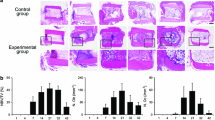Abstract
Platelet-derived growth factor (PDGF), abundant in bone tissue, has been reported to stimulate mesenchymal cell proliferation and migration. To elucidate the functional roles of PDGF during fracture healing, we investigated the expression of PDGF-A and -B chain proteins and receptor α and β mRNAs in fractured mouse tibiae. Twelve-week-old male BALB/c mice were operated on to make a closed fracture on the proximal tibia. On days 2, 4, 7, 10, 14, 21, and 28 after the operation, the fractured tibiae were excised, fixed with 4% paraformaldehyde, decalcified with 20% EDTA, and embedded in paraffin to prepare 7-µm sections. Immunohistochemistry using polyclonal antibodies against human PDGF-A and -B chains was carried out by the avidin-biotin-peroxidase method. For in situ hybridization, we used digoxigenin-labeled single-stranded DNA probes specific for mouse PDGF receptors α and β generated by unidirectional polymerase chain reaction. In the inflammatory phase on days 2–4 after the fracture, mesenchymal cells gathering at the fracture site expressed the PDGF-B chain and β receptor mRNA. At the stage of cartilaginous callus formation on day 7, the immunoreactivity for PDGF-A and -B chains on proliferating and hypertrophic chondrocytes and the signals of α and β receptor mRNAs on proliferating chondrocytes became manifest. At the stage of bony callus and bone remodeling on days 14–21, the predominant expression of the PDGF-B chain and β receptor was observed on both osteoclasts and osteoblasts. On day 28, signals for PDGF ligand proteins and receptor mRNAs diminished. The coincidental localization of PDGF ligands and their receptors implies a paracrine and autocrine mechanism. Our data suggested that PDGF contributed in part to the promotion of the chondrogenic and osteogenic changes of mesenchymal cells from the early to the midphase of fracture healing; the functions mediated by the β receptor, including cell migration, might be prerequisites to the recruitment of mesenchymal cells in the initial step and to the interaction between osteoclasts and osteoblasts in the bone remodeling phase.
Similar content being viewed by others
Author information
Authors and Affiliations
Additional information
Accepted: 2 June 1999
Rights and permissions
About this article
Cite this article
Fujii, H., Kitazawa, R., Maeda, S. et al. Expression of platelet-derived growth factor proteins and their receptor α and β mRNAs during fracture healing in the normal mouse. Histochemistry 112, 131–138 (1999). https://doi.org/10.1007/s004180050399
Issue Date:
DOI: https://doi.org/10.1007/s004180050399




